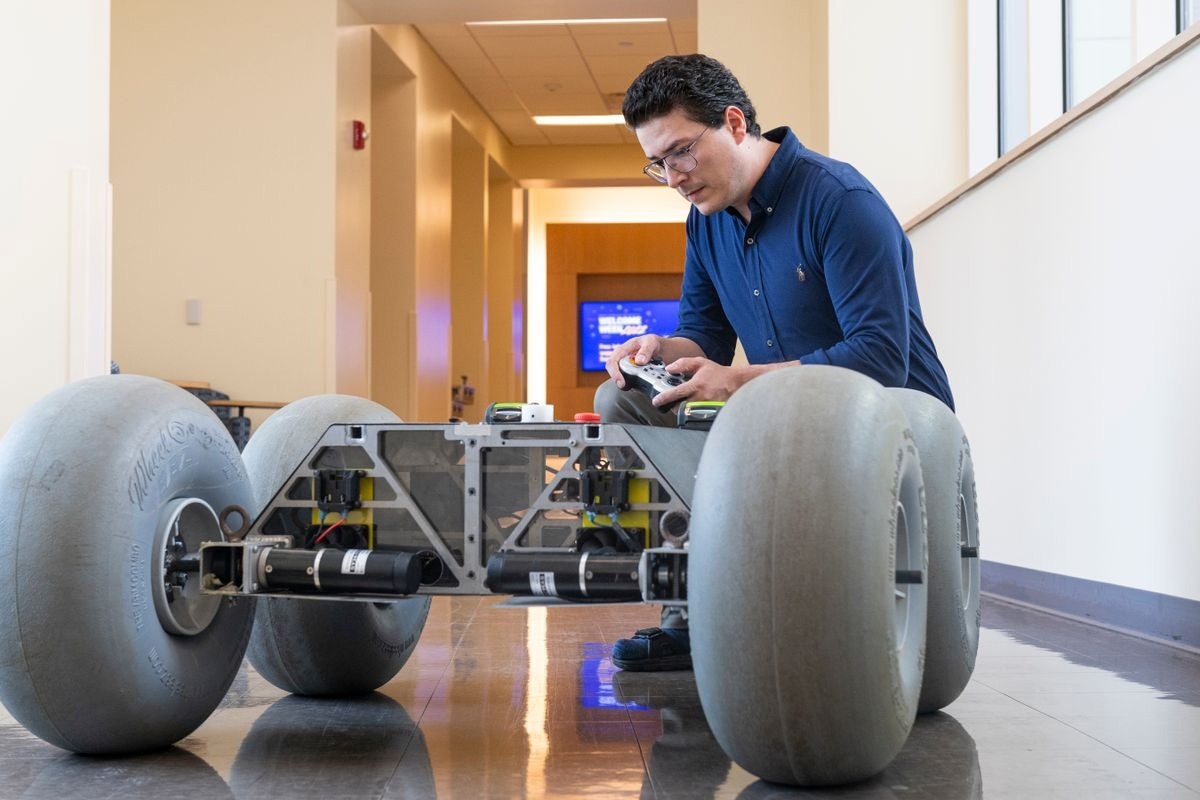In a new project, West Virginia University engineers are introducing robots to assist workers in their jobs by preventing slips, falls, and other hazardous situations.

Cagri Kilic, postdoctoral research fellow in the WVU Statler College of Engineering and Mineral Resources, shows off a rover that he developed to research slips in planetary rovers. Two other researchers are applying this same technology to improve safety in retail and wholesale settings. Image Credit: WVU Photo/Matt Sunday
Yu Gu and Jason Gross, associate professors in the Department of Mechanical and Aerospace Engineering, have been awarded $367,000 by the National Science Foundation to research techniques to reduce the danger of falling in retail settings.
Gu and Gross will employ robots to scope out and identify dangers along the floor surfaces of wholesale and retail areas to accomplish this.
There is a significant problem with slip and fall in retail spaces. So, we’re trying to figure out a way to use robots to provide situational awareness, monitor risks and provide walkability maps.
Jason Gross, Interim Chairperson, Mechanical and Aerospace Engineering, West Virginia University
According to the study, occupational accidents have impacted wholesale and retail labor due to high incidence rates and injury counts. The authors also mentioned that grocery and drug stores had some of the highest nonfatal injury rates. Every year, around 570,000 people are injured in the wholesale and retail industries.
Students collaborating with Gu and Gross are creating a robot “testbed” to simulate a retail setting in which the team may research and polish their approach to how robots can identify possible threats.
According to Gu, one method is to outfit robots with cameras.
Some might say, ‘Why not use the security cameras already in the stores to detect slip and fall risk?’. The limitation is in appearance, which can be deceiving. It is better to not only equip a robot with a camera but to drive it on the surface to see how slippery it is. The wheels of the robot are a better estimate of slip risk.
Yu Gu, Associate Professors, Mechanical and Aerospace Engineering, West Virginia University
Gu and Gross stated three goals for their study, which was conducted in partnership with the University of Florida. The first step is to identify and assess the overall risks connected with the use of robots in those working contexts.
The second goal is to create a new function that may help a variety of robots survey the indoor ground surface while still performing primary activities such as serving as a shopping guide. Information will be used to build real-time indoor space walkability maps that will alert walkers about potential hazards.
Finally, the study team will look into how robots and walkability maps affect workers’ physical fall risk exposure, cognitive workload, and psychological effects on these locations.
Gu stated that this research builds on previous work done by Cagri Kilic, a postdoctoral research scholar at the Statler College of Engineering and Mineral Resources in the WVU Navigation Lab. Kilic directed a study on estimating slippage in planetary rovers. He devised a method for extraplanetary rovers to navigate hazardous terrain using nonvisual data.
“Because of that research, we can easily estimate the slip based on wheel-and-terrain interaction. We can strategically turn the wheels in certain ways to better estimate slip while we drive,” Gu said.
“We have this ability, as the robot drives, to monitor the onboard sensors and compare the wheel speed versus the actual speed of the robot. We can infer slip, and can deploy a slip meter occasionally to calibrate that,” Gross said.
The company also intends to test the robots after hours in a real-world retail environment.
We’ve done this with a robot traversing a certain, single area, but branching out to combine that with the camera data is one of the exciting research aspects of the project.
Jason Gross, Interim Chairperson, Mechanical and Aerospace Engineering, West Virginia University